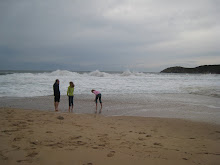Madame Marron mère visited this summer and went with the girls and me up to the Loire Valley. We went to Paris first and then drove out of the city to Versailles, so that E and G could tick the Hall of Mirrors box on their list. Madame Mère has not driven in France (as one wouldn't, if one did not live here and have to take the children to school), so as we loaded up at the end of our day at the palace, I handed her the map and told her where we going. It was 54 kilometers from Versailles to Maintenon, about 45 minutes' drive.
Two hours later, I passed a road sign that let me know we were 20 kilometers from Paris.
That was not where we were going.
Here's what our Cultural Awareness Training Professional told C and me before we came to France: France is a High Context culture, and the United States is a Low Context Culture. When we were told this, we nodded politely at this particular bit of sociological gobbledygook and checked to see when it would be lunchtime. However.
In High Context cultures, according to our Cultural Awareness Handbook, people see the present through the lens of the past. History matters. People work in order to be able to take vacations and spend time with their families. The community matters more than the individual. Time is elastic; you get there when you get there, the work gets done when it gets done, and don't forget to stop for a drink. In Low Context cultures, people think more about the future and less about the past; people place more value on their work life; the individual comes first; time is money.
And, in High Context cultures, the road signs are different. The road names are different. In fact, the road may not have a real name at all, it may just be called the road that goes to Maintenon, or, the road that comes out of Maintenon and then becomes the road that goes to Chartres. In the fine print of the map you may notice that it is called the D17, but you have to be an adept at parsing French road signs to notice the very very small yellow etiquette at the top of the panneau that mentions it. And chances are that instead of noticing that teeny tiny sign, you are busy trying to find Wazem on the map in your lap, since that's what your daughter just told you to look for, and not realizing that it's spelled Oisème.
French directional signs tell you not where you are, but where you are going. American signs tell you where you are, not where you are going. French signs list the places that the road will go through on its way to the next major village or town: that's how you orient yourself. You have left Versailles, going towards Rambouillet. After Rambouillet, you'll get to Epernon, unless you go left at the rond point, in which case you'll get to Orphin instead. In America, you leave Richmond and you head south. If you want to go west, you take a different road. Charlottesville happens to be on that westerly road, but what you know, first and foremost, is that you're on the road going west. I have yet to see a French road sign that mentioned a cardinal direction.
So this was disorienting for Madame Mère, as you might imagine. She's one of the most oriented people I know. She doesn't get lost. She knows where she is and can tell you whether she's facing north, south, east or west at any given moment. Also, pronouncing words in English: aces at it. We would reach rond points and I would call out the possibilities: Epernon, Hanches, Raizeux, Droue, and she would have not the first clue. Just a minute, she would say. I'm looking at the map. Take the southwest exit.
There is no southwest exit. Hanches, Raizeux, or Droue.
How do you spell that?
Which?
At least rond points are round; you can go around them all day while you figure out which direction is southwest. It's one of the best measures of culture shock that I know, going from being able not only to read and interpret the road signs but also being able to stop at any service station for directions if you lose your way, to not being able to connect what the road signs say with the way that they are pronounced, much less being able to ask a local for directions.
The locals know the directions, of course. So did their parents, and grandparents, and back before that. The road to Maintenon has been the road to Maintenon since well before the Marquise de Maintenon used to travel it from Versailles in the days of Louis XIV. The road to Chartres from Maintenon: it's led people to the cathedral for 800 years. The mecs from Paris who thought up the system of road numbering came along only within the last century, and these roads, which have outlasted the Bourbons, the Bonapartes, and the Boches during the Occupation will, God willing, outlast the numbering system, too.
That's what High Context is: knowing that Louis XIV travelled this road to visit his (secret) wife, the Marquise. It was the route de Maintenon long before anyone who travelled it had ever heard of the cardinal points of the compass. And that's the difference between French and American roads. When the customs of American roads were being thought up, the roads were cutting through vast, mysterious, awesome wilderness. Cardinal points, north, south, east, west, mattered. They were the only way that the young Americans had of imposing order and meaning. And, too, they were comfortably devoid of context: a road north does not carry the cultural freight of a road to the castle or the church.
Order and meaning in the old world, though: they're just laying around in heaps. Meaning is there for the taking, as long as you know how to spell it and pronounce it. A doctorate in French history doesn't hurt, either.
After the first day, Madame Mère drove and I took charge of the map.
Monday, October 6, 2008
Subscribe to:
Post Comments (Atom)






































No comments:
Post a Comment